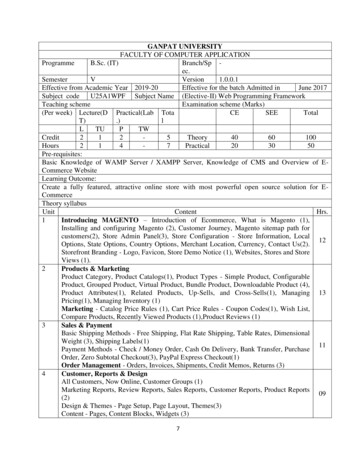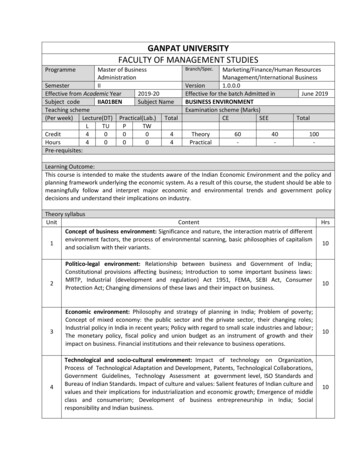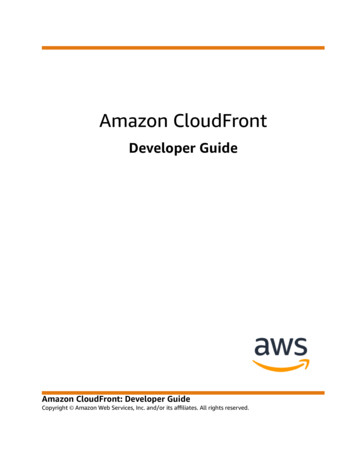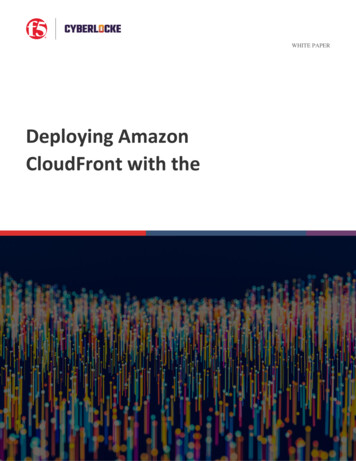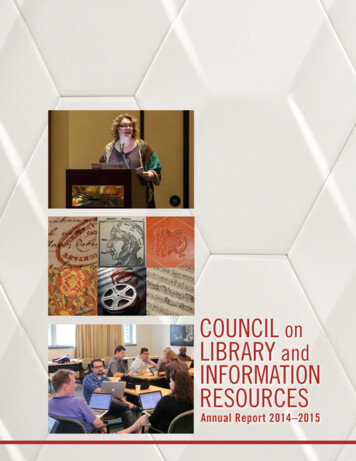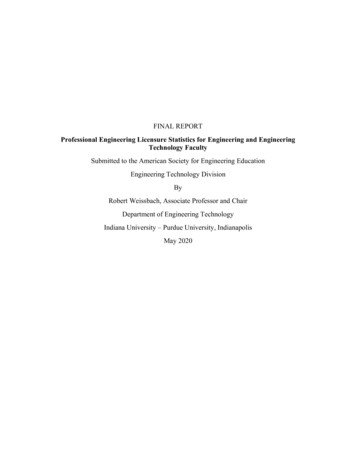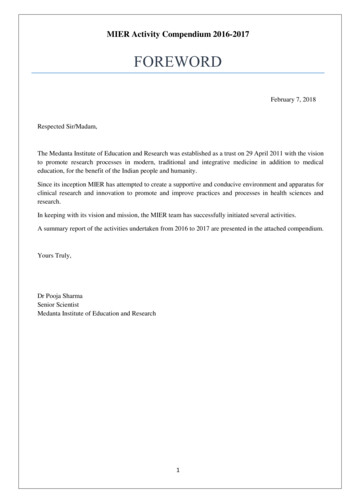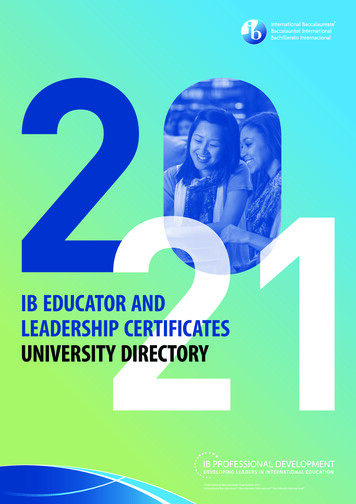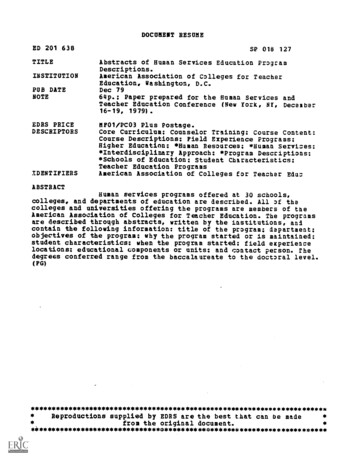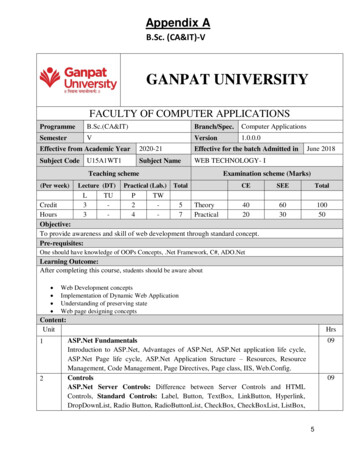
Transcription
Appendix AB.Sc. (CA&IT)-VGANPAT UNIVERSITYFACULTY OF COMPUTER ter ApplicationsSemesterVVersion1.0.0.0Effective from Academic YearSubject CodeU15A1WT12020-21Effective for the batch Admitted inSubject NameWEB TECHNOLOGY- ITeaching scheme(Per week)Lecture (DT)L33TU-Examination scheme (Marks)Practical (Lab.)P24June ctive:To provide awareness and skill of web development through standard concept.Pre-requisites:SEETotal603010050One should have knowledge of OOPs Concepts, .Net Framework, C#, ADO.NetLearning Outcome:After completing this course, students should be aware about Web Development conceptsImplementation of Dynamic Web ApplicationUnderstanding of preserving stateWeb page designing conceptsContent:Unit12Hrs09ASP.Net FundamentalsIntroduction to ASP.Net, Advantages of ASP.Net, ASP.Net application life cycle,ASP.Net Page life cycle, ASP.Net Application Structure – Resources, ResourceManagement, Code Management, Page Directives, Page class, IIS, Web.Config.ControlsASP.Net Server Controls: Difference between Server Controls and HTMLControls, Standard Controls: Label, Button, TextBox, LinkButton, Hyperlink,DropDownList, Radio Button, RadioButtonList, CheckBox, CheckBoxList, ListBox,095
Image, Calendar, AdRotator, FileUpload, MultiView, Validation ularExpressionValidator,CompareValidator, CustomValidator, ValidationSummary, Navigation Controls:SiteMapPath, Menu, TreeView345ASP.Net Page Designing Perspectives and ConceptsMaster Page, Skin File, Theme, Stylesheet, Introduction to AJAX, Basic Controls ofAJAX, Web Service: Introduction, Implementation, UsageDatabase ManipulationData Controls: GridView, DetailsView, FormView, Repeater, Chart, DatabaseManipulations using ADO.Net, Advanced GridView Manipulations, Using StoredProcedures, Reporting FacilityState Management TechniquesIntroduction to state management, State management Techniques - Session, Application,Cache, Cookie, ViewState, QueryString, Profile, Control statePractical Content:List of programs specified by the subject teacher based on above mentioned topicsReference Books:Beginning ASP.NET 3.5 in C# 2008, 2nd edition by Matthew MacDonald, Apress1Pro ASP.NET 3.5 in C# 2008, 2nd edition by Matthew MacDonald and Mario Szpuszta, Apress2C# 2008 Programming Covers .NET 3.5, Black Book, Dreamtech Press3ASP .Net 3.5. Unleashed, SAMS, Pearson t PLWPirh4EWFpGdA3VPS9umbvP6YGT3hUU91Question Paper Scheme:University Examination Duration: 3 HoursNote for Examiner: Q-1 must be common from any topics from syllabus.Q-2 and onwards must be from specific topics and internal choice or option can be given.SECTION – IQ-1 (Attempt any Five Out of Seven: each question must be 6 marks) – 30Questions must be covered all possible section.SECTION – IIQ-2 (Must be from topics: 1 and 2 (6 6))Q-3 (Must be from topics: 3 and 4(6 6))Q-4 (Must be from topic: 5(6))6090909
GANPAT UNIVERSITYFACULTY OF COMPUTER ter e from Academic YearSubject CodeU15A2BWDSubject NameTeaching scheme(Per week)Lecture (DT)L33TU-Examination scheme (Marks)Practical (Lab.)P24Effective for the batch Admitted in June 2018BASIC WEB PROGRAMMING Hours7Practical203050Objective:To aware students about open source technologies used in web application development and also makefamiliar them with the use of CMS to develop and manage blog and e-commerce application.Pre-requisites:HTML, CSS and JavaScriptLearning Outcome:After completing this course, students should be able to: Understand the syntax and structural elements of PHP Use PHP data types, control-flow structures, date, array and string functions Build form to collect information from a user Store and retrieve data from MySQL using PHP Design and develop blog and e-commerce application using WordPress and Joomla Develop a web application using PHPContent:Unit12Hrs9Introduction to PHPWeb-Technologies, Server side technologies, Web-server, Web-browser,Introduction PHP, Future of PHP, Installation of PHP, adding PHP to HTMLSyntax and variable, control and function, Passing information between page, String,Array and Array Function, Date FunctionAdvance concepts in PHPFile and File system Function, Session, Cookies, Exception and Error Handling97
9Database Connectivity using MySQLPHP/MySQL Connection, PHP/MySQL Connection and function, Display Query intables, Building forms from queries9WordPress4Introduction to CMS, Why WordPress? Downloading and Installing WordPress,Dashboard and Settings, Working with Content, Working with Page, Bog, Users andRoles, plugging.9Joomla5Joomla Architecture, Exploring Joomla Control Panel, Working with Toolbar,Working with Menus, Advance Concepts in JoomlaPractical Content:List of programs specified by the subject teacher based on above mentioned topicsReference Books:PHP 5 and MySQL Bible 1st Edition by Tim Converse , Joyce Park , Clark Morgan , Wiley1Publication, Inc.2The Complete Reference PHP 1st edition by Steven Holzner, TATA McGraw-Hill Publication3Beginning PHP and MySQL 4th edition by W. Jason Gilmore, Apress Publication4Beginning WordPress 1st edition by Stephanie Leary, Apress pplications-php2Question Paper Scheme:University Examination Duration: 3 HoursNote for Examiner: Q-1 must be common from any topics from syllabus.Q-2 and onwards must be from specific topics and internal choice or option can be given.SECTION – IQ-1 (Attempt any Five Out of Seven: each question must be 6 marks) – 30Questions must be covered all possible section.SECTION – IIQ-2 (Must be from topics: 1 and 2 (6 6))Q-3 (Must be from topics: 3 and 4(6 6))Q-4 (Must be from topic: 5(6))38
GANPAT UNIVERSITYFACULTY OF COMPUTER ter ApplicationsSemesterVVersion1.0.0.1Effective from Academic YearSubject CodeU15A3OS2020-21Effective for the batch Admitted inSubject NameOPERATING SYSTEMTeaching scheme(Per week)Lecture (DT)L33TU-Examination scheme (Marks)Practical (Lab.)P24June actical203050Objective:The Objective is to learn about concepts of Operating System, Process Management, ProcessSynchronization, Deadlocks, Logical Memory, Physical Memory, Virtual Memory and Overview of Unix.Pre-requisites:Basic knowledge of Operating System and Unix.Learning Outcome:By the end of this module students should be able to learn Fundamentals of Operating System Concepts of Process Management Clear understanding of Memory Management Different type of memory such as Physical Memory, Logical Memory and Virtual Memory Overview of Deadlock Unix, Implement Command and Prepare shell scriptContent:Unit1Operating System Overview and Process Management :Introduction to Operating System, Types of Operating system, Distributed OperatingSystem, Computing Environments, Operating System Services, System Calls and Typesof System Calls, Operating System Structure, Process, Process Control Block (PCB),Process States, Schedulers, Scheduling Queues, Scheduling Algorithms–FCFS, SJF,Priority, Round Robin (RR)2Process Synchronization :Critical section Problem-Mutual Exclusion, Process and Bounded Waiting, Semaphore,Classical Problems in Synchronization - The bounded buffer problem, The Readers and9Hrs109
Writers Problem, The Dinning Philosophers Problem345Deadlocks :Deadlock Characterizations, Methods of Handling Deadlocks, Deadlock Prevention Mutual Exclusion, Hold and Wait, No Pre-emption, Circular Wait, Deadlock Avoidance Safe State, Resource Allocation Graph Algorithm, Resource Request Algorithm, Deadlock RecoveryMemory Management:Logical versus Physical Address Space, Swapping, Contiguous Memory Allocation,Memory Mapping and protection, Memory Allocation, Fragmentation, Paging-Hardwaresupport, Protection, Shared Pages, Segmentation, Fixed and variable size partitioning,Virtual Memory, Demand Paging, Page Replacement Algorithms- FIFO, LRU,OPTIMALUnix Overview:Features of Unix, Unix Commands, Types of shell, Unix file system, Introduction to theKernel: Architecture of the UNIX operating system, Editors of Unix, Unix memorymanagement.Practical Content:List of programs specified by the subject teacher based on above mentioned topicsReference Books:1.Operating System Concept by Silberschatz & Galvin-Wiley, Fifth Edition2.Operating System, Second Edition by Milan Milenkovi’c - TMH3.Operating System, Fourth Edition by William Stallings – PHI4.Unix Shell Programming, by Yashavant Kanetkar - n Paper Scheme:University Examination Duration: 3 HoursNote for Examiner: Q-1 must be common from any topics from syllabus.Q-2 and onwards must be from specific topics and internal choice or option can be given.SECTION – IQ-1 (Attempt any Five Out of Seven: each question must be 6 marks) – 30Questions must be covered all possible section.SECTION – IIQ-2 (Must be from topics: 1 and 2 (6 6))Q-3 (Must be from topics: 3 and 4(6 6))Q-4 (Must be from topic: 5(6))10998
GANPAT UNIVERSITYFACULTY OF COMPUTER ter e from Academic YearSubject Code U15A4NTIISubject NameTeaching scheme(Per week)Lecture (DT)L22TU-June 2018Examination scheme (Marks)Practical (Lab.)P12Effective for the batch Admitted inNETWORK TECHNOLOGY – tical203050Objective:To learn about computer network and protocols with various types of services. The aim is to provide theknowledge of network administration and configuration.Pre-requisites:Types of Computer Network, OSI and TCP/IP Reference Model with Protocols and Basic Knowledge ofOperating System.Learning Outcome:By the end of this module students should be able to Learn and implement Computer Network with practical approach. Get the idea about of the windows 2008 server administration and management. Study about Mobile IP addressing in computer network communication.Content:UnitHrs1Basics of Networking and Network ImplementationWork group model / Peer-to-peer Networks, Domain Model / Server-BasedNetworks, Types of Servers, FTP server Configuration, Telnet, RemoteAssistance, Remote Desktop Sharing, IP Allocation, Crimping, LAN creation inwork group, Firewall Configuration, Basic Networking Command.72Proxy Server and Router Configuration ProtocolsIntroduction to Proxy Server, Types of Proxies, Introduction to VLAN and types ofVLANs, Intra Domain Routing Protocol and configuration: Distance Vector (RIP),Link State (OSPF), IGRP, Inter Domain Routing Protocol: Path Vector (BGP),Router configuration files, Default routing, Static routing, Dynamic routing.711
3Managing and Maintaining Windows Server 2008Installation of windows server 2008, Introduction of server rolls, Features of activedirectory, DNS configuring with active directory installation, managing users andmanaging group in active directory, Configuring DHCP, Group policy, Introductionto Domains, Domain controller and forests.74Managing Server 2008 services and VirtualizationActive directory lightweight directory services, Active directory certificateservices, Active directory rights management services, Active directory federationservices, Server virtualization, Backup and recovery in windows 2008 server.75Mobile Computers and Private NetworksArchitecture of Mobile IP technology, Mobile IP addressing, Introduction to theAgents, Mobile host phases, Introduction to the Private Network, Virtual PrivateNetwork(VPN), Network Address Translation(NAT).7Practical Content:List of practical specify by subject teacher based on above mention topics.Reference Books:1Microsoft Server 2008: Beginner ‘s Guide Marty Matthews, published by McGraw Hill2Cisco Certified Network Associate Study Guide (CCNA), Sybex Inc; Second Edition3TCP/IP Protocol Suite : B. A. Forouzan Fourth stion Paper Scheme:University Examination Duration: 3 HoursNote for Examiner: Q-1 must be common from any topics from syllabus.Q-2 and onwards must be from specific topics and internal choice or option can be given.SECTION – IQ-1 (Attempt any Five Out of Seven: each question must be 6 marks) – 30Questions must be covered all possible section.SECTION – IIQ-2 (Must be from topics: 1 and 2 (6 6))Q-3 (Must be from topics: 3 and 4(6 6))Q-4 (Must be from topic: 5(6))12
GANPAT UNIVERSITYFACULTY OF COMPUTER ter ApplicationsSemesterVVersion1.0.0.0Effective from Academic YearU15A5IP1Subject Code2020-21Effective for the batch Admitted inSubject NameINDUSTRIAL PROJECT – ITeaching scheme(Per week)Lecture(DT)L-TU-Examination scheme (Marks)Practical(Lab.)P44June 150100250Objective:Industrial Project -I course is an organized method or activity of enhancing and improving skill set andknowledge of computer science students which boost their performance and consequently helping them tomeet their career objectives. Industrial Project is crucial for students because it is the best way to acquire asmuch mastery about their field as possible which helps in building confidence of the students.Pre-requisites:SDLC, Models for Software Engineering, OOPs, Basic DBMS concepts, Design Techniques like DFD orUML etc., Basic Information of Business Processes according to project title.Learning Outcome: Understanding of how system is analyzed and implemented using standard techniques. Design and Implementation of proposed system. Testing the system. Deployment of the system.Content:Unit1ContentHrsRules: The project development shall be carried out along with the regular subject incurriculum during the semester. The students can develop their project individuallyor in a group of not more than 3 students.The passing standard is 40% in internal and external examination jointly.The detail study of any enterprise application or any major IT infrastructure setupcan also be accepted as a project work. The project can be developed in anylanguage or platform but it is required to get approved by the head of theinstitution. For the purpose of approval, Students have to submit their project titlesand proposals with the name of internal and external guides to the Head ofInstitution In case, if the student proposal is rejected, the revised proposal in the13
same or other area is required to submit and get it sanctioned. Failing to do this,his/her term will not be granted.The students have to report to the internal guide for at least 4 times during theproject life span. Students are required to submit their presentation in soft copy asper format to assigned internal guide at least before 4 days of internal presentationschedule.The external examiners appointed by the University will give the external marks onthe basis of the heads like Presentation, Demonstration, Viva Voce, andDocumentation etc. The distribution of marks to different heads may be decided atthe time of evaluation of the project but it is expected to have the same distribution.The Internal Guide or Head of the Institution will give the internal marks. Thesemarks may be given on the bases of regular reporting of the student to the internalguide.Internal ExaminationInternal HeadWeightage (60%)Presentations25 %Project Analysis 10 %Project10 %DesigningTechnical10 %aspectsProject5%OutcomesExternal ExaminationExternal HeadFinal Viva Presentation(Project Analysis, ProjectDesigning, Technicalaspects etc)Report SubmissionWeightage (40%)25 %15%14
GANPAT UNIVERSITYFACULTY OF COMPUTER ter ApplicationsSemesterVVersion1.0.0.1Effective from Academic YearSubject CodeU15B6BAA2020-21Effective for the batch Admitted inSubject NameBUSINESS ANALYSIS AND ANALYTICSTeaching scheme(Per week)Lecture (DT)L23TU-Examination scheme (Marks)Practical (Lab.)P-June acticalObjective:To gain fundamental awareness and understanding of the business analysis and analytics. The student willlearn various business analysis techniques and tools to add their value to the business.Pre-requisites:Fair understanding of business functionsMicrosoft Excel skillLearning Outcome:After completing this course, students should be able to: Analyse stockholders Implement stockholder management strategy Implement investigation techniques Find out data issues within dataset and classify dataset Calculate summary statistics Solve business problems using MS ExcelContent:Unit1HrsFundamentals of Business Analysis and AnalyticsUnderstanding business analysis and analytics, Introduction to Big Data, Introduction toBusiness Intelligence, Types of business analytics , Business analytics process, Overviewof knowledge area in business analysis, The business analysis maturity model, Role &responsibility of IT business analyst and analytics, Application of business analytics159
2The Competencies of Business Analyst and Stockholder AnalysisPersonal qualities, Business knowledge, Professional techniques, The development ofcompetenciesStakeholder analysis and management —Types of stakeholders, Analysis of stockholder,Stockholder management strategy, Understating stakeholders perspectives93Investigation TechniquesBrainstorming, Interviews, Survey/Questionnaire ,Observation, Workshops ,Scenarios,Prototyping , Quantitative Approach , Documenting the present situation94Visualization/Data IssuesCommunicating the value of business Analytics, Relationship of businessprocess and Organization decision – making process, Organization/Sources ofdata ,Types of data, Importance of data quality , Dealing with missing orincomplete data , Data ClassificationBusiness Modeling959Introduction to business analytics tools, Solving business problems using tools- Visualize data, Validate data, Calculate summary statistics, Using ExcelSolver(transportation/distribution problem, schedule workforce problem)Reference Books:1Business Analysis 3rd edition by Debra Paul, Donald Yeates & James Cadle Published by BCSLearning & Development Ltd2Business Analytics Principles, Concepts, and Applications with SAS 1 st edition by Marc J.Schniederjans, Dara G. Schniederjans , Christopher M. Starkey published by Pearson Education,IncBusiness Analytics: The Science of Data - Driven Decision Making 1st edition by U Dinesh3Kumar published by Wiley India Pvt. Ltd.4Microsoft Excel Data Analysis and Business Modeling by Wayne L.Winston published byMicrosoft PressQuestion Paper Scheme:University Examination Duration: 3 HoursNote for Examiner: Q-1 must be common from any topics from syllabus.Q-2 and onwards must be from specific topics and internal choice or option can be given.SECTION – IQ-1 (Attempt any Five Out of Seven: each question must be 6 marks) – 30Questions must be covered all possible section.SECTION – IIQ-2 (Must be from topics: 1 and 2 (6 6))Q-3 (Must be from topics: 3 and 4(6 6))Q-4 (Must be from topic: 5(6))16
HTML, CSS and JavaScript Learning Outcome: After completing this course, students should be able to: . 3 9Database Connectivity using MySQL PHP/MySQL Connection, PHP/MySQL Connection and function, Display Query in tables, Building forms from queries 4 WordPress

